This article was originally published in the January/February 2022 Issue of the WatchTime print magazine.
If you want to discreetly find out the time, you shouldn’t look at your own watch, but at the one that’s opposite you. That’s no problem at all if the person sitting across from you — whether they’re a pilot or not — is wearing the Sinn 717. This big watch is an on-board instrument for the wrist. It’s an enormous 45 mm in diameter, but size isn’t the only reason why it’s so easy to read. Its dial is indeed based on the face of an on-board clock, Sinn’s historic NaBo 17 ZM. The “ZM” here stands for Zentral-Minute, which is German for central minute, but we’ll say more about this later. Even in the dark, this watch is easy to read and, thanks to anti-reflective coating on both sides of the sapphire crystal above the dial, the face remains legible even under challenging visibility conditions and from different angles.
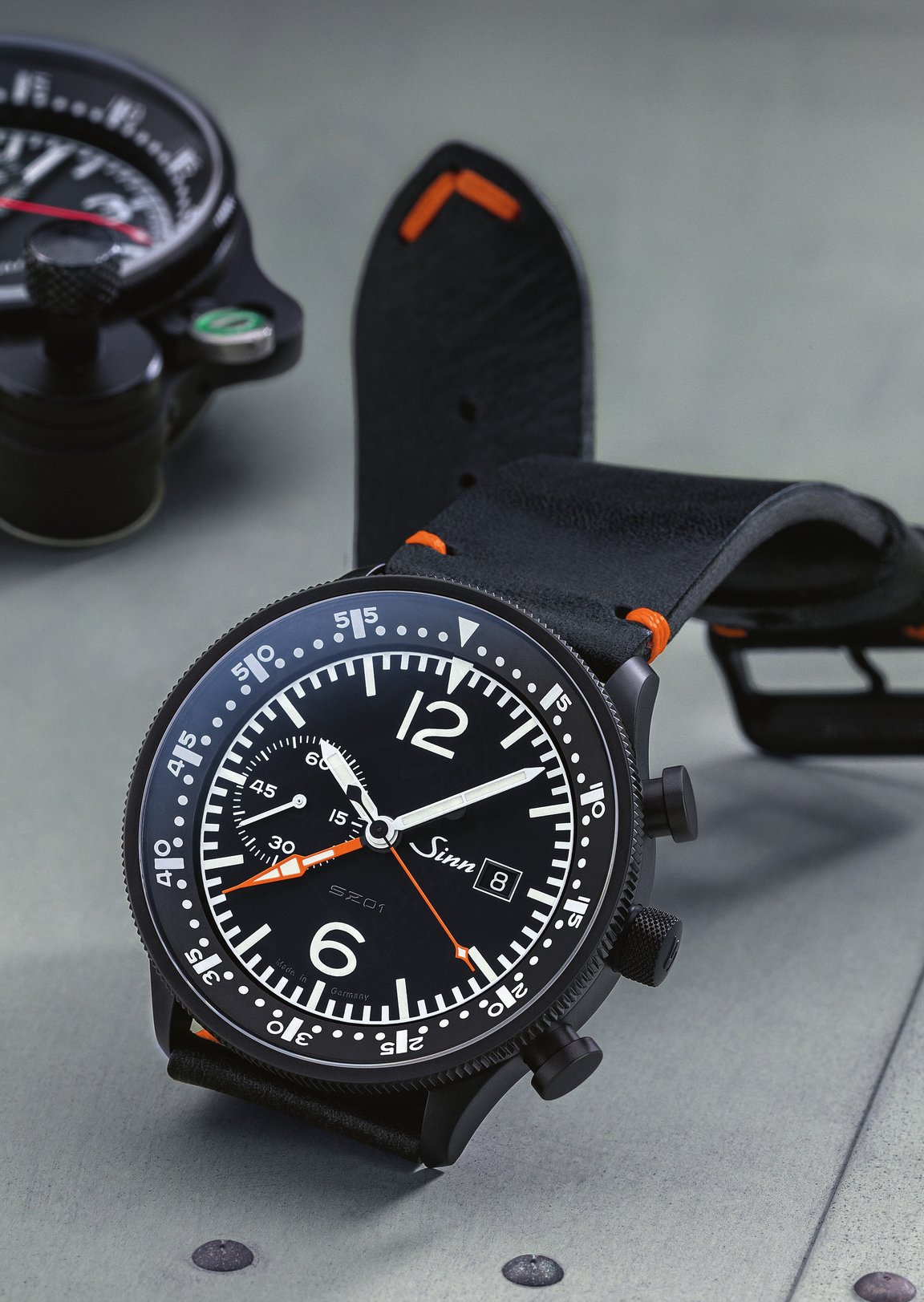
Sinn’s owner and managing director Lothar Schmidt told us that a pilot had sent him a historical NaBo 17 ZM that had been salvaged from a crashed aircraft. But this wasn’t the inspiration for the 717. Before that, one or two customers had asked him to reissue the old cockpit chronograph. Schmidt gave the matter some thought and decided that it would be a good idea for the company’s anniversary. After all, the company became known for pilots’ watches and on-board clocks in the early 1960s.
The NaBo 17 ZM was developed toward the end of the 1970s for the Luftwaffe’s Tornado program and still keeps time today in the Bundeswehr’s Tornado aircraft. It was also used in the F-104 Starfighter, in the Breguet Atlantic, a naval maritime patrol aircraft, and in Bundeswehr helicopters like the Bölkow Bo 105. It was powered by Valjoux’s hand-wound chronograph Caliber 558, which shows the elapsing seconds and minutes via orange central hands, hence the abbreviation “ZM.” Its balance is paced at 18,000 vibrations per hour and it displays the continually running seconds on a subdial at 12 o’clock. This is an unusual position for the seconds subdial, but it’s not surprising because the movement is rotated 90 degrees before it’s enclosed in the case so it can be easily operated using the chronograph’s two big buttons at the 5 and the 7 and the large crown at 6 o’clock.

Reference 717 is Designed Like an On-board Clock
At first glance, this 90° rotation seems to be almost the only major difference between the historical clock and the new Reference 717, because Schmidt wanted the design of the watch to stay as close as possible to the original. While other concepts were considered, this modern chronograph has its control buttons classically positioned on the right side of the case and the small seconds hand circles the dial at 9 o’clock. The subdial for the seconds is nearly identical to its counterpart on the on-board clock, although the clock has an overall diameter of 57 mm. The watch’s somewhat shortened hour index at 9 protrudes into the circle of strokes around the subdial, while the clock’s triangular index at the 12 similarly protrudes into the subdial on its face. Of course, a triangle also marks the 12 on the 717. The numeral 6 on the watch is shown in the same typeface as on the clock. A numeral 12 is added to the watch’s dial below the triangle.
The watch has no numeral 9, thus freeing space for the seconds subdial, and the 3 has been omitted in favor of a date window. To stay closer to the design of the clock’s dial with no date, it might have been better to omit the date window from the watch because the date is positioned quite deeply below the dial and is difficult to read. In terms of legibility, however, this is the watch’s only flaw. Large hour and minute indexes along with wide baton-shaped hands never leave any doubt about the time. Even the design of the hands was faithfully adopted from the historical model down to their smallest details — the surfaces where luminous paint is applied, the pointed tips, and even the short ends of the orange elapsed-time hands.

Some readers might wonder about the many central hands and why this watch has chronograph pushers on the side of its case but no subdials for the stopwatch function. To clearly display the elapsed seconds and minutes from the center of the dial, Sinn developed its own cadrature on the movement and dial sides, thus creating Caliber SZ01. This caliber was integrated into the once widely used ETA/Valjoux 7750 for the EZM10 in 2011. The central format for the elapsed-time display is both clear and intuitively readable because the 60 elapsing minutes are shown just like the minutes on a normal time display. There is, however, one potential disadvantage: the 717 has no hour counter, so it can only record brief intervals up to a maximum of one hour in duration.
In-house Chronograph Cadrature Integrated In the Movement
Most of our readers are probably aware that ETA no longer delivers Caliber 7750. The alternative is named C99001 and is made in La Chaux-de-Fonds by Concepto Watch Factory SA, which was founded in 2006. Schmidt pointed out that it took only a few minimal interventions to integrate the chronograph conversion into the new basic movement, and he said he was well satisfied with the results.
Schmidt has every reason to be satisfied because the rate values are very good. The 717 gained between 2 and 3 seconds per day and the timekeeping showed only slight differences among the several positions. This watch ran even more accurately on the wrist, where we measured a daily gain of just 1.6 seconds. The chronograph was shown to be reliable as well. The historically inspired, mushroom-shaped buttons are palpably convincing thanks to their contact surfaces, which are large and smooth, but not slippery. The pressure points are surprisingly even and nothing short of perfect. The buttons also glide very smoothly in their bushings.
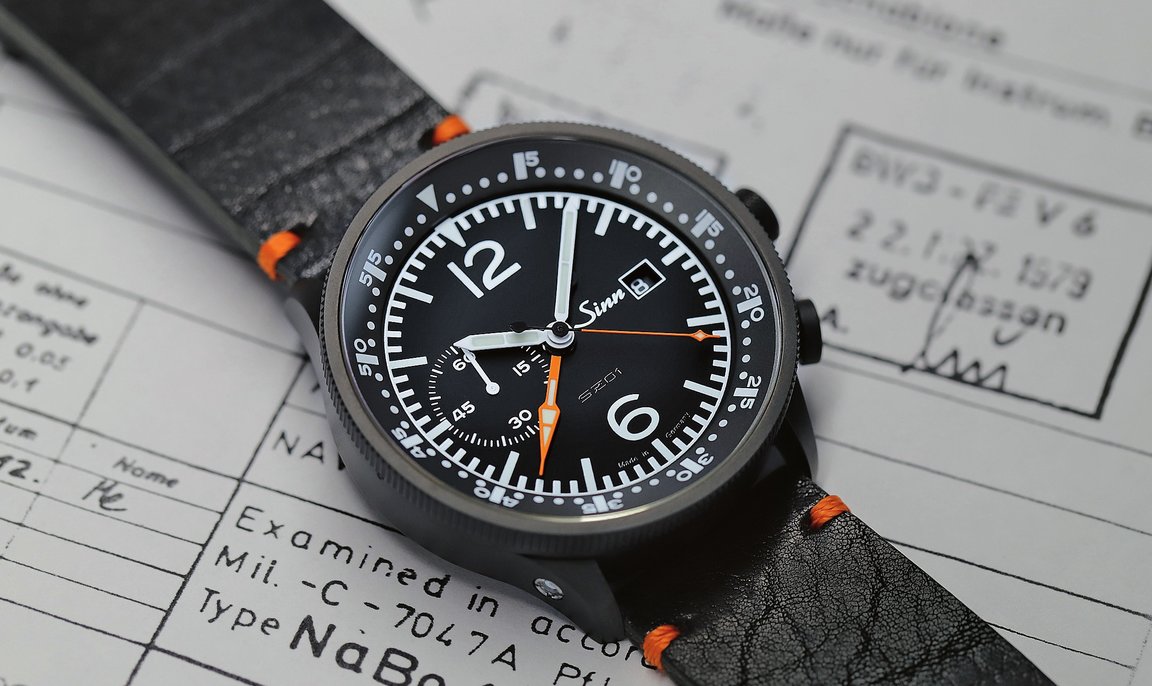
When the stopwatch function is triggered, a narrow orange elapsed-seconds needle with a diamond-shaped tip begins to sweep around the dial. This slim hand sweeps through 60 seconds and, at exactly the moment when it crosses its zero mark at the 12, the chronograph’s wider elapsed-minutes hand with its arrow-shaped tip changes position. This differs from the situation on the NaBo 17 ZM on-board chronograph, where both the elapsed-minutes hand and the elapsed-seconds hand move continuously.
The bidirectional rotating bezel system is a special feature of the 717 and a source of pride for Sinn. Its mechanism combines an inner flange and an outer rotating ring, which can be used, for example, to mark departure or arrival times. A very similar system already existed on the NaBo 17 ZM.
Excellent Rotating Bezel and Special Technologies
Manually turning the outer knurled bezel causes the inner bezel, which looks like a flange, to rotate together with the sapphire crystal. Their motion is continuous and they can be turned in either direction. The advantage of this construction is a spacious view of the dial, but the challenge is to create a hermetic seal between the entire rotating system and the central part of the case. Engineer Schmidt explained that it is much easier to seal the crown that moves a rotating ring than to seal a bezel with a large radius. A specially designed seal, developed and tested in collaboration with Sächsische Uhrentechnologie GmbH Glashütte (SUG), guarantees that the 717 can withstand pressure up to 20 bar, which corresponds to the conditions at a depth of 200 meters. This degree of watertightness was a goal of Sinn’s for the 717. What’s more, this model is tested according to dive watch standards, which means that an additional 25 percent is added to the pressure of 20 bar. Tests have shown that the 717 withstands this much high pressure just as well as it copes with low pressure of 0.2 bar. To achieve this, specially tensioned seals are required to prevent the pressed-in crystal from shattering or popping off when the pressure outside the case is lower than the pressure inside. Sinn guarantees this protection against low pressure for all its pilots’ watches, but this is especially impressive for the 717 because at least 12 square centimeters of crystal surface must be secured.

In addition to all this, smooth and secure rotation of the entire system must also be guaranteed. The resistance to rotation is between 10 and 20 Newton meters and it must be individually adjusted for each watch. The system rotates the same way as does the lens of a camera, with a fairly high but palpably pleasant resistance, which assures the user that it would be nearly impossible to accidently adjust the bezel. The system can also be operated while wearing gloves. And the outer rotating ring cannot be lost because it’s screwed into place. The scale on the inner ring runs in close proximity to the dial and hands, which enables more accurate adjustment of the rotating bezel and better readability. The chronograph’s hands extend quite far toward the rotating bezel: such close proximity could not be achieved with an outer bezel. When adjusting the rotating bezel, you can see that the minute markers are exactly opposite their counterparts on the dial — a degree of perfection Sinn has upheld for many years.
Of course, other in-house technologies are used in this anniversary pilots’ watch. Ardehumidifying technology is also on-board. Thanks to a capsule filled with copper sulfate, which binds moisture but does not release it, a special seal and a protective filling of inert gas keep the movement surrounded by a bone-dry atmosphere. This reduces aging processes and prevents fogging on the underside of the crystal. Since copper sulfate takes on a blue color with increasing moisture, the chemical’s color serves as an indicator of the degree of saturation of the dehumidifying substance inside the capsule. The capsule can be viewed through a small window of sapphire at 7:30 on the side of the case.

An Especially Hard Case Made In-house
The 717 pilots’ watch takes off with an in-housemade case supplied by SUG. This is confirmed by the SUG logo between the strap lugs at 6 o’clock. Schmidt co-founded SUG in 1999 and today is the company’s majority shareholder. The all-black case combines an ultra-hard coating and a tegimented base. Tegimentation does not involve the application of a coating; instead, the base material, i.e., stainless steel, is hardened by means of a special process. This creates a protective outer layer, which makes the case much less susceptible to scratches than ordinary stainless steel. The hard coating is then applied to the tegimented surface. The special combination of materials prevents the coating from flaking.
A strong strap made of black leather is firmly affixed between the strap lugs to match the on-board timekeeping instrument on the wrist. Orange stitching contrasts handsomely with the black leather. The color scheme continues with the orange chronograph hands on the black dial and atop the black case. A simple but strong pin buckle closes the strap. The Sinn 717 pilots’ watch touches down with pinpoint accuracy, despite its large size.
Sinn 717 Specs:
Manufacturer: Sinn Spezialuhren GmbH, Wilhelm-Fay-Strasse 21, 65936 Frankfurt am Main, Germany
Reference number: 717.010
Functions: Hours, minutes, seconds on a subdial, chronograph (central elapsed seconds and up to 60 elapsed minutes), date, Ar-dehumidifying technology, antimagnetic according to DIN 8309, inner rotating pilots’ bezel with luminous triangle
Movement: SZ01 based on Concepto C99001, automatic, 28,800 vph (4 Hz), 28 jewels, Glucydur balance, Nivarox hairspring, fine adjustment via bipartite regulator, Nivarox shock absorption, 46-hour power reserve, diameter = 30.4 mm, height = 8.60 mm
Case: Bead-blasted stainless steel case with black coating of hard material, tegimented base, water resistant to 200 m
Strap and clasp: Leather strap with pin buckle
Rate results: Deviation in seconds per 24 hours (Fully wound / after 24 hours)
Dimensions: Diameter = 44.02 mm, lug width = 24 mm, height = 13.39 mm, weight = 136.5 g
Variations: With rubber strap ($5,450)
Price: $5,160
Scores:
Strap and clasp (max. 10 points): The large strap matches the generous dimensions of this watch; the buckle is simple. 8
Case (10): The case is very robust, stainless steel, hardened with the aid of a special technology and coated with hard material; good details, exclusive bezel system. 9
Dial and hands (10): Very clear styling, strong contrasts, based on the historical predecessor. 9
Design (15): The style, which refers to the historical model, is implemented very consistently and functionally. 14
Legibility (5): Perfect legibility both day and night of the time and elapsed time; strong contrasts; the date display is too small. 4
Operation (5): The screw-down crown, pushpieces and the bezel system are very easy to use. 5
Wearing comfort (5): The case is quite tall, but this watch is still very comfortable to wear thanks to its construction; the strap is very robust. 4
Movement (20): Special chronograph cadrature integrated into new base caliber. 16
Rate results (10): Well-balanced rate behavior; the watch ran more accurately on the wrist than on the timing machine. 9
Overall value (10): The price in direct sales puts the 717 on a par with chronographs from Omega or Tudor; you get a lot of technology and functionality for the money. 9
TOTAL: 86 points
To learn more about Sinn, click here, and to subscribe to the WatchTime print magazine, click here.

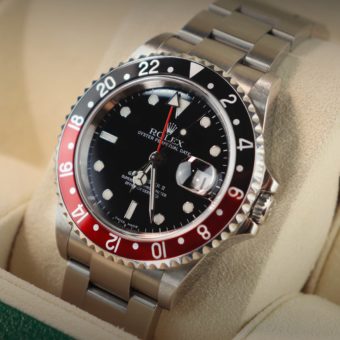
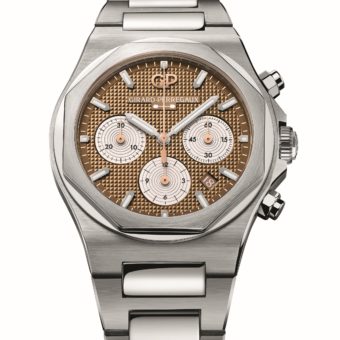

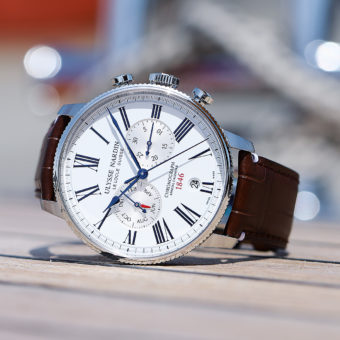
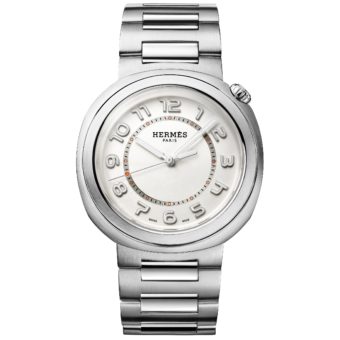
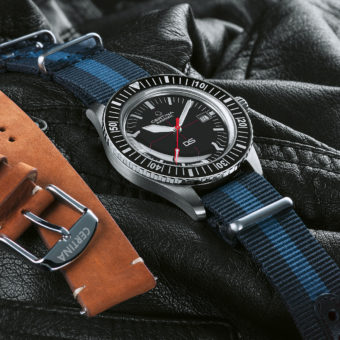
45 mm is not enormous. It’s just right for a pilot’s watch.